Unit 6 Space and beyond Developing ideas Reading 课件 (共37张PPT)2024-2025学年高二英语外研版(2019)选择性必修4
文档属性
| 名称 | Unit 6 Space and beyond Developing ideas Reading 课件 (共37张PPT)2024-2025学年高二英语外研版(2019)选择性必修4 | 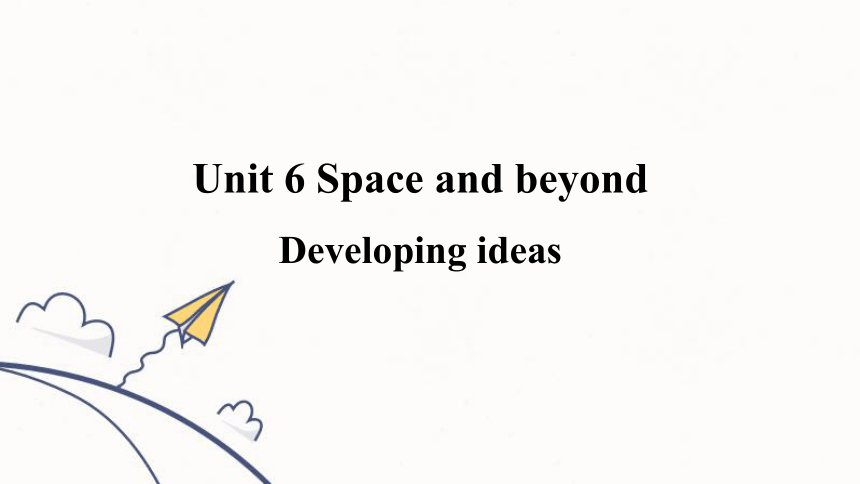 | |
| 格式 | pptx | ||
| 文件大小 | 30.9MB | ||
| 资源类型 | 教案 | ||
| 版本资源 | 外研版(2019) | ||
| 科目 | 英语 | ||
| 更新时间 | 2025-04-22 17:33:01 | ||
图片预览


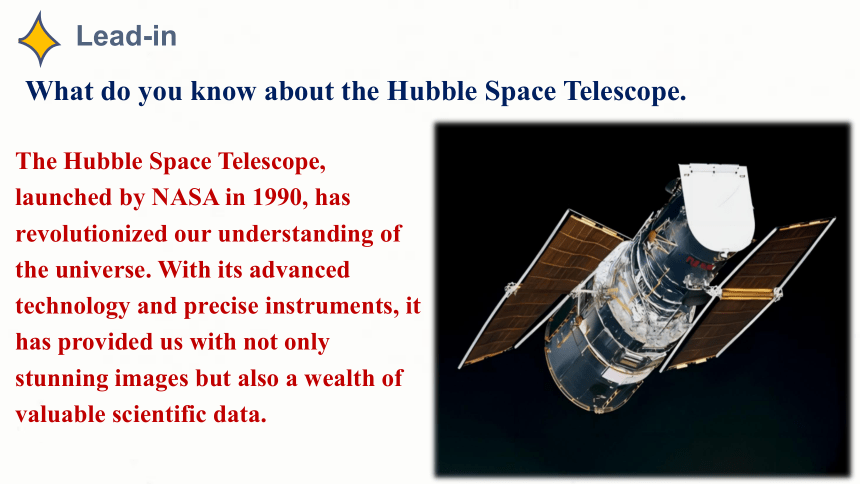
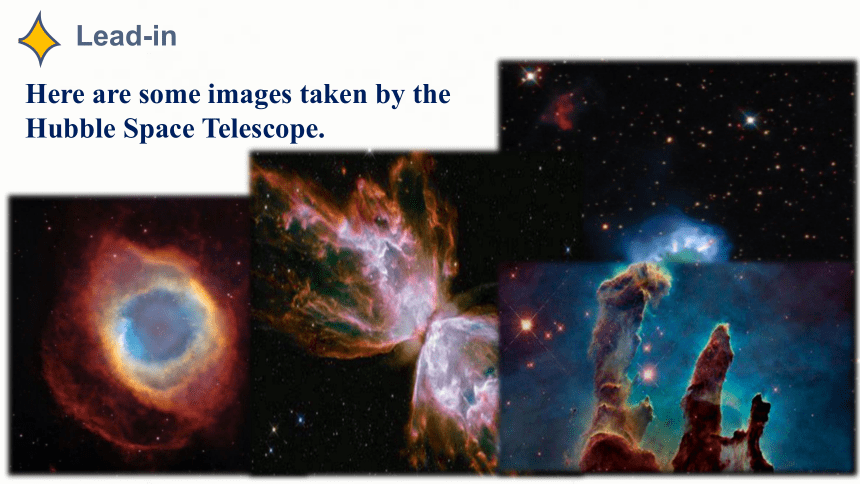


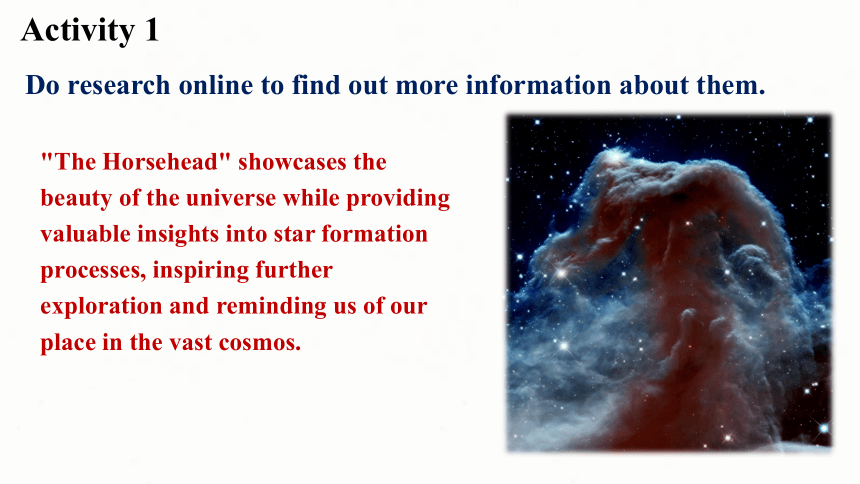
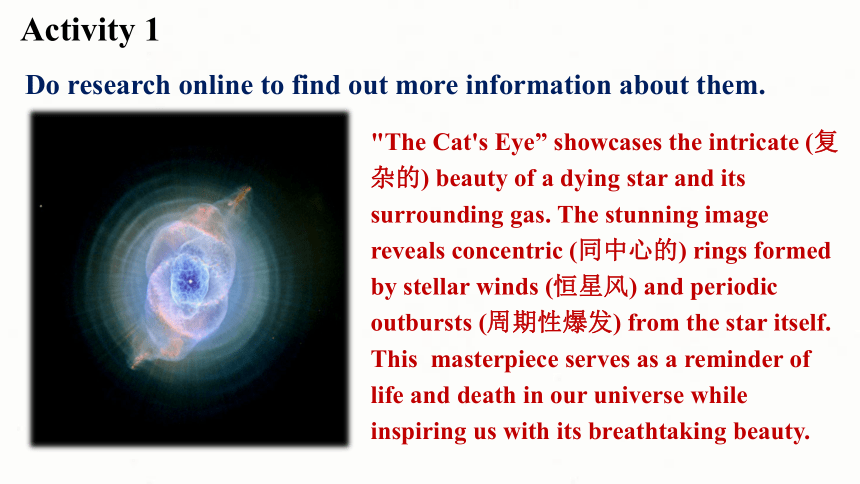
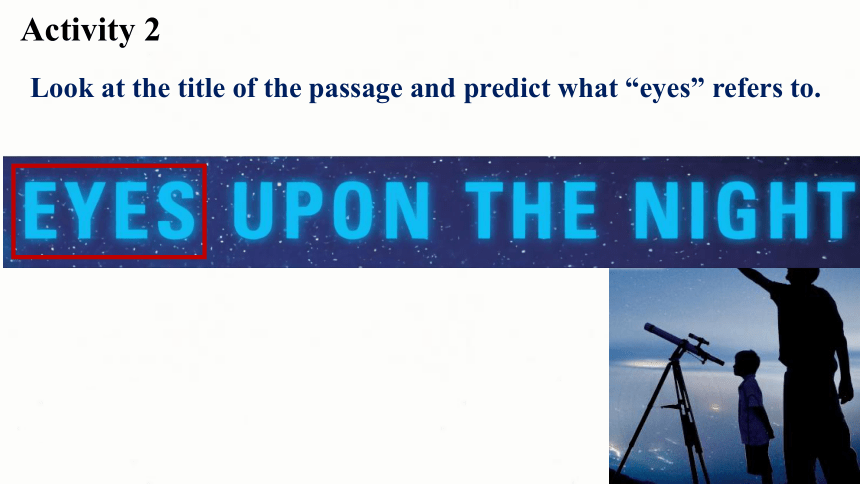
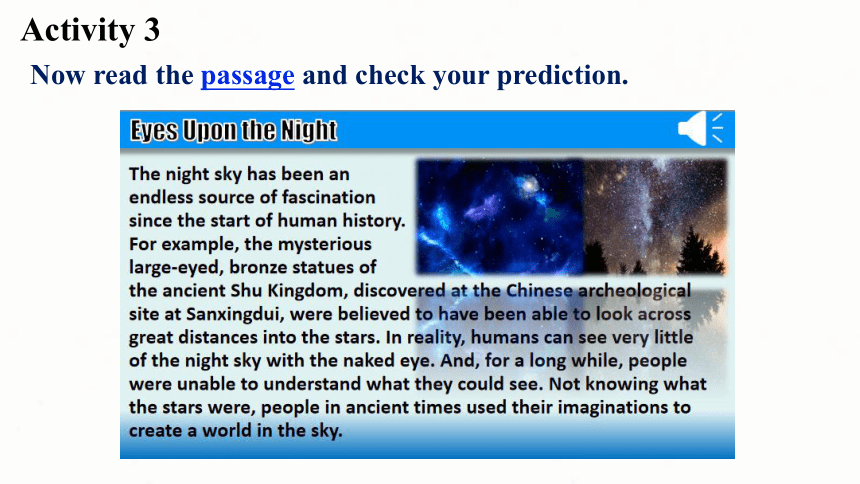
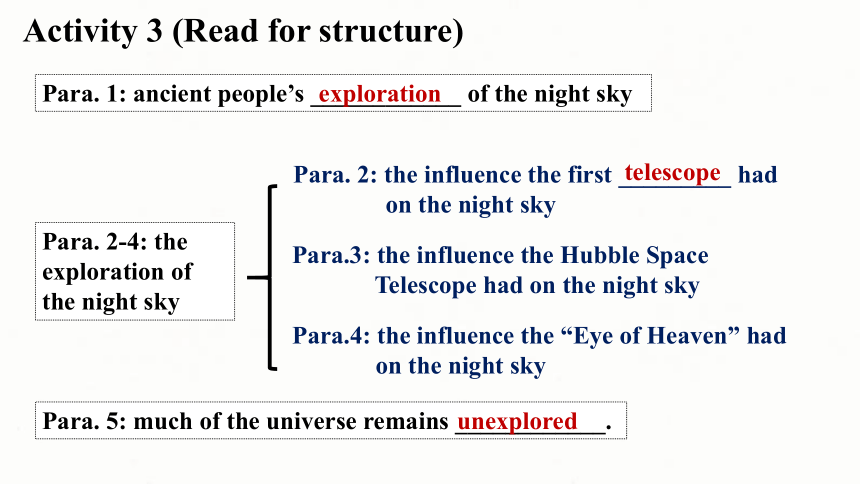
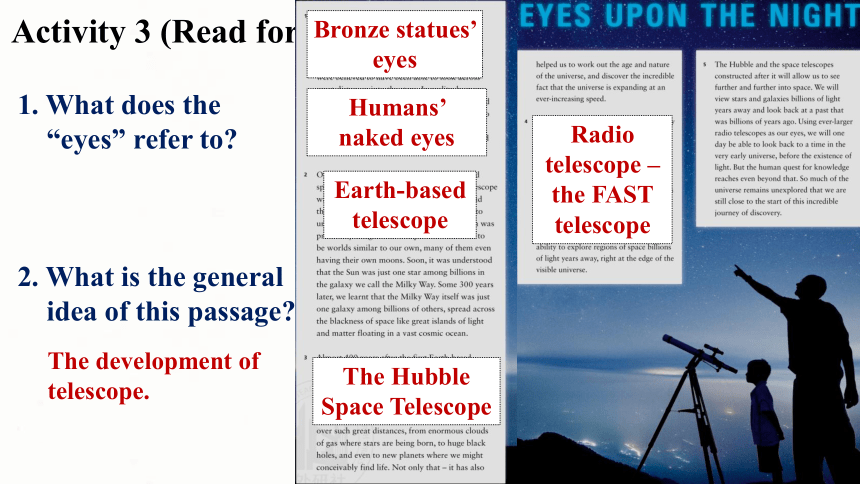
文档简介
(共37张PPT)
Developing ideas
Unit 6 Space and beyond
In this class, you will
acquire and state information concerning the Hubble Space Telescope.
read a passage and learn about the development of telescope and human’s journey of exploration.
give a talk about Humphry Davy’s quote.
write a journal entry about living in space.
Learning objectives
What do you know about the Hubble Space Telescope.
The Hubble Space Telescope, launched by NASA in 1990, has revolutionized our understanding of the universe. With its advanced technology and precise instruments, it has provided us with not only stunning images but also a wealth of valuable scientific data.
Lead-in
Here are some images taken by the Hubble Space Telescope.
Lead-in
Match the images taken by the Hubble Space Telescope to their nicknames.
The Cat’s Eye
The Pillars of Creation
The Horsehead
Activity 1
Do research online to find out more information about them.
"The Pillars of Creation" showcases the beauty and power of the universe, revealing colossal (巨大的) structures where new stars are born. This image allows scientists to study star formation in detail and inspires awe and curiosity about our place in the vast cosmos.
Activity 1
"The Horsehead" showcases the beauty of the universe while providing valuable insights into star formation processes, inspiring further exploration and reminding us of our place in the vast cosmos.
Activity 1
Do research online to find out more information about them.
"The Cat's Eye” showcases the intricate (复杂的) beauty of a dying star and its surrounding gas. The stunning image reveals concentric (同中心的) rings formed by stellar winds (恒星风) and periodic outbursts (周期性爆发) from the star itself. This masterpiece serves as a reminder of life and death in our universe while inspiring us with its breathtaking beauty.
Activity 1
Do research online to find out more information about them.
Look at the title of the passage and predict what “eyes” refers to.
Activity 2
Now read the passage and check your prediction.
Activity 3
Para. 1: ancient people’s ____________ of the night sky
Para. 2-4: the exploration of the night sky
Para. 2: the influence the first _________ had on the night sky
Para.3: the influence the Hubble Space Telescope had on the night sky
Para. 5: much of the universe remains ____________.
telescope
Para.4: the influence the “Eye of Heaven” had on the night sky
unexplored
exploration
Activity 3 (Read for structure)
Activity 3 (Read for general idea))
Bronze statues’ eyes
Humans’ naked eyes
Earth-based telescope
The Hubble Space Telescope
Radio telescope – the FAST telescope
1. What does the “eyes” refer to
2. What is the general idea of this passage
The development of telescope.
Activity 3 (Read for general idea))
Bronze statues’ eyes
Humans’ naked eyes
Earth-based telescope
The Hubble Space Telescope
Radio telescope – the FAST telescope
3. In what order is the passage developed
In time order.
What can be seen through the “eyes”
The night sky has been an endless source of fascination since the start of human history. For example, the mysterious large-eyed, bronze statues of the ancient Shu Kingdom, discovered at the Chinese archaeological site at Sanxingdui, were believed to have been able to look across great distances into the stars.
In reality, humans can see very little of the night sky with the naked eye. And, for a long while, people were unable to understand what they could see. Not knowing what the stars were, people in ancient times used their imaginations to create a world in the sky.
Bronze statues’ eyes
Humans’ naked eyes
Activity 3 (Read for details)
What can be seen through the “eyes”
Our power to investigate and thus understand space changed dramatically when the first telescope was angled at the night sky, increasing as it did the power of the human eye and enabling us to understand that the universe is far larger than was previously imaginable. The planets were seen to be worlds similar to our own, many of them even having their own moons. Soon, it was understood that the Sun was just one star among billions in the galaxy we call the Milky Way. Some 300 years later, we learnt that the Milky Way itself was just one galaxy among billions of others, spread across the blackness of space like great islands of light and matter floating in a vast cosmic ocean.
Earth-based telescope
How does the development change us
Activity 3 (Read for details)
What can be seen through the “eyes”
Almost 400 years after the first Earth-based telescope was invented, the Hubble Space Telescopes was launched into orbit, giving astronomers indeed all of us- the first breathtakingly beautiful images of our universe taken from beyond Earth. Nothing in history has allowed us to see so much over such great distances, from enormous clouds of gas where stars are being born, to huge black holes, and even to new planets where we might conceivably find life. Not only that- it has also helped us to work out the age and nature of the universe and discover the incredible fact that the universe is expanding at an ever-increasing speed.
How does the development change us
The Hubble Space Telescope
Activity 3 (Read for details)
What can be seen through the “eyes”
To see even further into the universe, many countries are now engaged in building ever more advanced telescopes. Currently, China operates the world’s largest and most powerful radio telescope, the FAST telescope, completed in 2016. The 500-metre dish of the “Eye of Heaven”, as it is known, is being used in the search for dark matter, thought to be composed of subatomic particles invisible to ordinary telescopes. This vast dish also has the ability to explore regions of space billions of light years away, right at the edge of the visible universe.
How does the development change us
Radio telescope – the FAST telescope
Activity 3 (Read for details)
How will the development in astronomy change us in the future
The Hubble and the space telescopes constructed after it will allow us to see further and further into space. We will view stars and galaxies billions of light years away and look back at a past that was billions of years ago. Using ever-larger radio telescopes as our eyes, we will one day be able to look back to a time in the very early universe, before the existence of light. But the human quest for knowledge reaches even beyond that. So much of the universe remains unexplored that we are still close to the start of this incredible journey of discovery.
Activity 3 (Read for details)
Complete the timeline with information from the passage.
Thousands of years ago, people already regarded the night sky as an _________________________. It was believed that the huge eyes of the large-eyed bronze statues from the Chinese archaeological site at Sanxingdui were able to ____________________________________.
Our power to see the sky changed dramatically when _______________________________________. It extended _________________________ and caused us to realise that the universe is a far larger place than we ever imagined.
endless source of fascination
look across great distances into the stars
the first telescope was angled at the night sky
the power of the human eye
Activity 3 (Read for details)
Complete the timeline with information from the passage.
In 1990, the Hubble Space Telescope was launched into orbit. For the first time, people could ________________________________________
____________________________________. These ranged from ______________________________________, and even to new planets.
In 2016, __________________was built in China. It is used in the search for dark matter, which cannot be observed by ordinary telescopes. Its ________ has the ability to make discoveries beyond our imaginations.
enormous clouds of gas to huge black holes
see breathtakingly beautiful images of our universe taken from beyond Earth
the FAST telescope
vast dish
Activity 3 (Read for details)
1. Why do you think people have always been interested in the stars
People's interest in stars stems from their beauty and mystery, navigational importance, scientific significance, and curiosity about the unknown.
Activity 4 (Think and share)
2. Which development in astronomy mentioned in the passage has made the greatest impression on you
The Hubble Space Telescope has made the greatest impression on me because of its remarkable contributions to our understanding of the universe. Its ability to capture breathtaking images and gather valuable data from distant galaxies, stars, and planets is truly awe-inspiring. The discoveries made by the Hubble have opened up new avenues for scientific exploration.
Activity 4 (Think and share)
3. In what different ways do the two reading passages in this unit reflect the spirit of exploration
The first passage is about the Challenger disaster. Although it was a tragedy, people did not stop exploring space. This shows that people will always seek to explore, even if some lose their lives in doing so. The second passage is about the development of the telescope, and how it reflects our desire to explore the unknown. Unlike the exploration conducted by astronauts such as those in the Challenger, the exploration in the second passage was conducted by people located on Earth, at no personal risk. Nonetheless, the knowledge gained from telescopes is immense. The passages show that there are different ways of exploring the universe and of gaining knowledge.
Activity 4 (Think and share)
4. Have you ever used a telescope or been to planetarium Share your experience with the class.
Activity 4 (Think and share)
Work in groups. Give a talk about the quote.
The more we know, the more we feel our ignorance; the more we feel how much remains unknown.
--Humphry Davy
1. Talk about the meaning of Humphry Davy’s quote and whether you agree with it.
As we continue to learn and explore the world around us, we begin to realize just how vast and complex it truly is. Every new piece of information we uncover only serves to highlight the gaps in our knowledge, reminding us that there is always more to discover.
Activity 5
Work in groups. Give a talk about the quote.
The more we know, the more we feel our ignorance; the more we feel how much remains unknown.
--Humphry Davy
2. Organise your ideas by completing the notes.
Point of view
Arguments
Supporting examples
3. Share your ideas with the class.
Activity 5
Language points
课文回顾:
explore; engaged; larger; unexplored; look back to;
came into existence; advanced; with the help of
Even today, much of the universe remains ____________. In reality, humans can see very little of the night sky with the naked eye and the universe is far ______ than people once imagined. However, _______________ telescopes, humans can see much farther into space. Now, many countries are ________ in building even more __________ telescopes, which make it possible for people _________ regions of space billions of light years away. Perhaps in the future, people will be able to ___________ a time long before light _________________.
advanced
with the help of
engaged
unexplored
larger
to explore
look back to
came into existence
Fill in the blanks with the words and expressions in the box.
1. Soon, it was understood that the Sun was just one star among billions in the galaxy we call the Milky Way.
句意:不久,人们就明白了,太阳只是我们称为银河系的数十亿颗恒星中的一颗。
本句中的it是形式主语,而that the Sun was just one star among billions in the galaxy we call the Milky Way 是真正的主语。
常用于这种结构的动词还有:think, believe, report, say, know, suggest, announce等。
It’s said that a large number of paper-cutting works by experts throughout China will be on show.
据悉,大批来自全国各地的剪纸专家的作品将要展出。
It is a shame/no wonder/a pity... that ...
令人感到羞耻的事是/难怪/遗憾的是……
It is likely/surprising/interesting... that ...
很可能/令人吃惊的是/令人感兴趣的是……
It is said/believed/reported... that ... 据说/据信/据报道……
It has been announced ______ another manned space
shuttle will be sent up into space next year.
已经宣布另一架载人航天飞机将于明年发射升空。
______________ the industrial cities built in the nineteenth century do not attract visitors.
很遗憾,这些建于19世纪的工业城市对游客并没有吸引力。
【语法填空】
that
It is a pity that
2. Not only that—it has also helped us to work out the age and nature of the universe, and discover the incredible fact that universe is expanding at an ever increasing speed.
句意:不仅如此,它还帮助我们计算出宇宙的年龄和性质,并发现宇宙正在以不断加快的速度膨胀这一令人难以置信的事实。
work out 算出;理解;制定出;解决;锻炼
work on/at 从事于;致力于
at work 在工作;在运转
off work 在休假
out of work 失业
It was beyond belief that the little boy could work out such a problem.
令人难以置信的是,这个小男孩能解出这样一道题。
【语法填空】
If you work ____ in the morning, you’ll be likely to be as fresh as a daisy all day.
如果你在早上锻炼,你可能一整天都精力充沛。
The machine is ___ work smoothly.
机器正在平稳运转。
Harry has been ___________ for six months, so he has difficulty earning his living.
哈里已经失业六个月了, 因此他谋生有困难。
out
at
out of work
She said she had been engaged ____ Peter long before she came to the town. 她说她在进城之前很久就和彼得订了婚。
If we invest little time in a person, our ___________ (engage) with that person will decline. 如果我们在一个人身上投入的时间太少,我们与这个人的亲密关系就会变淡。
【语法填空】
engaged adj.忙碌的;使用中的;已订婚的;电话占线的
be engaged in 忙于;从事
be engaged to sb. 与某人订婚
engagement n. 婚约;约会;参与度
to
engagement
3. To see even further into the universe, many countries are now engaged in building even more advanced telescopes.
句意:为了更深入地观察宇宙,许多国家现在都在忙着建造更先进的望远镜。
4. The 500-metre dish of the “Eye of Heaven”, as it is known, is being used in the search for dark matter, thought to be composed of subatomic particles invisible to ordinary telescopes.
句意:这架名为“天堂之眼”的500米望远镜正在被用于寻找暗物质,暗物质被认为是由普通望远镜看不到的亚原子粒子组成的。
The houses in my hometown were chiefly composed of wood.
我家乡的房子主要由木头做成。
England, Scotland and Wales compose the island of Great Britain.
英格兰、苏格兰和威尔士组成了大不列颠岛国。
Mozart composed his last opera shortly before he died.
莫扎特在去世前不久创作了他的最后一部歌剧。
compose v. 组成; 作曲; 撰写
be composed of 由……组成
be made up of 由……组成(或构成)
consist of 由……组成(或构成)
【语法填空】
It is well known that water is composed _____ hydrogen and oxygen.
This machine is made up ____ many different parts.
Their diet consists largely ____ vegetables.
of
of
of
5. Nothing in history has allowed us to see so much over such great distances, from enormous clouds of gas where stars are being born, to huge black holes, and even to new planets where we might conceivably find life.
句意:历史上没有什么能让我们在如此遥远的距离上看到如此多的东西,从恒星诞生的巨大气体云,到巨大的黑洞,甚至到我们可能发现生命的新行星。
where引导定语从句
where引导定语从句
句子结构分析
Developing ideas
Unit 6 Space and beyond
In this class, you will
acquire and state information concerning the Hubble Space Telescope.
read a passage and learn about the development of telescope and human’s journey of exploration.
give a talk about Humphry Davy’s quote.
write a journal entry about living in space.
Learning objectives
What do you know about the Hubble Space Telescope.
The Hubble Space Telescope, launched by NASA in 1990, has revolutionized our understanding of the universe. With its advanced technology and precise instruments, it has provided us with not only stunning images but also a wealth of valuable scientific data.
Lead-in
Here are some images taken by the Hubble Space Telescope.
Lead-in
Match the images taken by the Hubble Space Telescope to their nicknames.
The Cat’s Eye
The Pillars of Creation
The Horsehead
Activity 1
Do research online to find out more information about them.
"The Pillars of Creation" showcases the beauty and power of the universe, revealing colossal (巨大的) structures where new stars are born. This image allows scientists to study star formation in detail and inspires awe and curiosity about our place in the vast cosmos.
Activity 1
"The Horsehead" showcases the beauty of the universe while providing valuable insights into star formation processes, inspiring further exploration and reminding us of our place in the vast cosmos.
Activity 1
Do research online to find out more information about them.
"The Cat's Eye” showcases the intricate (复杂的) beauty of a dying star and its surrounding gas. The stunning image reveals concentric (同中心的) rings formed by stellar winds (恒星风) and periodic outbursts (周期性爆发) from the star itself. This masterpiece serves as a reminder of life and death in our universe while inspiring us with its breathtaking beauty.
Activity 1
Do research online to find out more information about them.
Look at the title of the passage and predict what “eyes” refers to.
Activity 2
Now read the passage and check your prediction.
Activity 3
Para. 1: ancient people’s ____________ of the night sky
Para. 2-4: the exploration of the night sky
Para. 2: the influence the first _________ had on the night sky
Para.3: the influence the Hubble Space Telescope had on the night sky
Para. 5: much of the universe remains ____________.
telescope
Para.4: the influence the “Eye of Heaven” had on the night sky
unexplored
exploration
Activity 3 (Read for structure)
Activity 3 (Read for general idea))
Bronze statues’ eyes
Humans’ naked eyes
Earth-based telescope
The Hubble Space Telescope
Radio telescope – the FAST telescope
1. What does the “eyes” refer to
2. What is the general idea of this passage
The development of telescope.
Activity 3 (Read for general idea))
Bronze statues’ eyes
Humans’ naked eyes
Earth-based telescope
The Hubble Space Telescope
Radio telescope – the FAST telescope
3. In what order is the passage developed
In time order.
What can be seen through the “eyes”
The night sky has been an endless source of fascination since the start of human history. For example, the mysterious large-eyed, bronze statues of the ancient Shu Kingdom, discovered at the Chinese archaeological site at Sanxingdui, were believed to have been able to look across great distances into the stars.
In reality, humans can see very little of the night sky with the naked eye. And, for a long while, people were unable to understand what they could see. Not knowing what the stars were, people in ancient times used their imaginations to create a world in the sky.
Bronze statues’ eyes
Humans’ naked eyes
Activity 3 (Read for details)
What can be seen through the “eyes”
Our power to investigate and thus understand space changed dramatically when the first telescope was angled at the night sky, increasing as it did the power of the human eye and enabling us to understand that the universe is far larger than was previously imaginable. The planets were seen to be worlds similar to our own, many of them even having their own moons. Soon, it was understood that the Sun was just one star among billions in the galaxy we call the Milky Way. Some 300 years later, we learnt that the Milky Way itself was just one galaxy among billions of others, spread across the blackness of space like great islands of light and matter floating in a vast cosmic ocean.
Earth-based telescope
How does the development change us
Activity 3 (Read for details)
What can be seen through the “eyes”
Almost 400 years after the first Earth-based telescope was invented, the Hubble Space Telescopes was launched into orbit, giving astronomers indeed all of us- the first breathtakingly beautiful images of our universe taken from beyond Earth. Nothing in history has allowed us to see so much over such great distances, from enormous clouds of gas where stars are being born, to huge black holes, and even to new planets where we might conceivably find life. Not only that- it has also helped us to work out the age and nature of the universe and discover the incredible fact that the universe is expanding at an ever-increasing speed.
How does the development change us
The Hubble Space Telescope
Activity 3 (Read for details)
What can be seen through the “eyes”
To see even further into the universe, many countries are now engaged in building ever more advanced telescopes. Currently, China operates the world’s largest and most powerful radio telescope, the FAST telescope, completed in 2016. The 500-metre dish of the “Eye of Heaven”, as it is known, is being used in the search for dark matter, thought to be composed of subatomic particles invisible to ordinary telescopes. This vast dish also has the ability to explore regions of space billions of light years away, right at the edge of the visible universe.
How does the development change us
Radio telescope – the FAST telescope
Activity 3 (Read for details)
How will the development in astronomy change us in the future
The Hubble and the space telescopes constructed after it will allow us to see further and further into space. We will view stars and galaxies billions of light years away and look back at a past that was billions of years ago. Using ever-larger radio telescopes as our eyes, we will one day be able to look back to a time in the very early universe, before the existence of light. But the human quest for knowledge reaches even beyond that. So much of the universe remains unexplored that we are still close to the start of this incredible journey of discovery.
Activity 3 (Read for details)
Complete the timeline with information from the passage.
Thousands of years ago, people already regarded the night sky as an _________________________. It was believed that the huge eyes of the large-eyed bronze statues from the Chinese archaeological site at Sanxingdui were able to ____________________________________.
Our power to see the sky changed dramatically when _______________________________________. It extended _________________________ and caused us to realise that the universe is a far larger place than we ever imagined.
endless source of fascination
look across great distances into the stars
the first telescope was angled at the night sky
the power of the human eye
Activity 3 (Read for details)
Complete the timeline with information from the passage.
In 1990, the Hubble Space Telescope was launched into orbit. For the first time, people could ________________________________________
____________________________________. These ranged from ______________________________________, and even to new planets.
In 2016, __________________was built in China. It is used in the search for dark matter, which cannot be observed by ordinary telescopes. Its ________ has the ability to make discoveries beyond our imaginations.
enormous clouds of gas to huge black holes
see breathtakingly beautiful images of our universe taken from beyond Earth
the FAST telescope
vast dish
Activity 3 (Read for details)
1. Why do you think people have always been interested in the stars
People's interest in stars stems from their beauty and mystery, navigational importance, scientific significance, and curiosity about the unknown.
Activity 4 (Think and share)
2. Which development in astronomy mentioned in the passage has made the greatest impression on you
The Hubble Space Telescope has made the greatest impression on me because of its remarkable contributions to our understanding of the universe. Its ability to capture breathtaking images and gather valuable data from distant galaxies, stars, and planets is truly awe-inspiring. The discoveries made by the Hubble have opened up new avenues for scientific exploration.
Activity 4 (Think and share)
3. In what different ways do the two reading passages in this unit reflect the spirit of exploration
The first passage is about the Challenger disaster. Although it was a tragedy, people did not stop exploring space. This shows that people will always seek to explore, even if some lose their lives in doing so. The second passage is about the development of the telescope, and how it reflects our desire to explore the unknown. Unlike the exploration conducted by astronauts such as those in the Challenger, the exploration in the second passage was conducted by people located on Earth, at no personal risk. Nonetheless, the knowledge gained from telescopes is immense. The passages show that there are different ways of exploring the universe and of gaining knowledge.
Activity 4 (Think and share)
4. Have you ever used a telescope or been to planetarium Share your experience with the class.
Activity 4 (Think and share)
Work in groups. Give a talk about the quote.
The more we know, the more we feel our ignorance; the more we feel how much remains unknown.
--Humphry Davy
1. Talk about the meaning of Humphry Davy’s quote and whether you agree with it.
As we continue to learn and explore the world around us, we begin to realize just how vast and complex it truly is. Every new piece of information we uncover only serves to highlight the gaps in our knowledge, reminding us that there is always more to discover.
Activity 5
Work in groups. Give a talk about the quote.
The more we know, the more we feel our ignorance; the more we feel how much remains unknown.
--Humphry Davy
2. Organise your ideas by completing the notes.
Point of view
Arguments
Supporting examples
3. Share your ideas with the class.
Activity 5
Language points
课文回顾:
explore; engaged; larger; unexplored; look back to;
came into existence; advanced; with the help of
Even today, much of the universe remains ____________. In reality, humans can see very little of the night sky with the naked eye and the universe is far ______ than people once imagined. However, _______________ telescopes, humans can see much farther into space. Now, many countries are ________ in building even more __________ telescopes, which make it possible for people _________ regions of space billions of light years away. Perhaps in the future, people will be able to ___________ a time long before light _________________.
advanced
with the help of
engaged
unexplored
larger
to explore
look back to
came into existence
Fill in the blanks with the words and expressions in the box.
1. Soon, it was understood that the Sun was just one star among billions in the galaxy we call the Milky Way.
句意:不久,人们就明白了,太阳只是我们称为银河系的数十亿颗恒星中的一颗。
本句中的it是形式主语,而that the Sun was just one star among billions in the galaxy we call the Milky Way 是真正的主语。
常用于这种结构的动词还有:think, believe, report, say, know, suggest, announce等。
It’s said that a large number of paper-cutting works by experts throughout China will be on show.
据悉,大批来自全国各地的剪纸专家的作品将要展出。
It is a shame/no wonder/a pity... that ...
令人感到羞耻的事是/难怪/遗憾的是……
It is likely/surprising/interesting... that ...
很可能/令人吃惊的是/令人感兴趣的是……
It is said/believed/reported... that ... 据说/据信/据报道……
It has been announced ______ another manned space
shuttle will be sent up into space next year.
已经宣布另一架载人航天飞机将于明年发射升空。
______________ the industrial cities built in the nineteenth century do not attract visitors.
很遗憾,这些建于19世纪的工业城市对游客并没有吸引力。
【语法填空】
that
It is a pity that
2. Not only that—it has also helped us to work out the age and nature of the universe, and discover the incredible fact that universe is expanding at an ever increasing speed.
句意:不仅如此,它还帮助我们计算出宇宙的年龄和性质,并发现宇宙正在以不断加快的速度膨胀这一令人难以置信的事实。
work out 算出;理解;制定出;解决;锻炼
work on/at 从事于;致力于
at work 在工作;在运转
off work 在休假
out of work 失业
It was beyond belief that the little boy could work out such a problem.
令人难以置信的是,这个小男孩能解出这样一道题。
【语法填空】
If you work ____ in the morning, you’ll be likely to be as fresh as a daisy all day.
如果你在早上锻炼,你可能一整天都精力充沛。
The machine is ___ work smoothly.
机器正在平稳运转。
Harry has been ___________ for six months, so he has difficulty earning his living.
哈里已经失业六个月了, 因此他谋生有困难。
out
at
out of work
She said she had been engaged ____ Peter long before she came to the town. 她说她在进城之前很久就和彼得订了婚。
If we invest little time in a person, our ___________ (engage) with that person will decline. 如果我们在一个人身上投入的时间太少,我们与这个人的亲密关系就会变淡。
【语法填空】
engaged adj.忙碌的;使用中的;已订婚的;电话占线的
be engaged in 忙于;从事
be engaged to sb. 与某人订婚
engagement n. 婚约;约会;参与度
to
engagement
3. To see even further into the universe, many countries are now engaged in building even more advanced telescopes.
句意:为了更深入地观察宇宙,许多国家现在都在忙着建造更先进的望远镜。
4. The 500-metre dish of the “Eye of Heaven”, as it is known, is being used in the search for dark matter, thought to be composed of subatomic particles invisible to ordinary telescopes.
句意:这架名为“天堂之眼”的500米望远镜正在被用于寻找暗物质,暗物质被认为是由普通望远镜看不到的亚原子粒子组成的。
The houses in my hometown were chiefly composed of wood.
我家乡的房子主要由木头做成。
England, Scotland and Wales compose the island of Great Britain.
英格兰、苏格兰和威尔士组成了大不列颠岛国。
Mozart composed his last opera shortly before he died.
莫扎特在去世前不久创作了他的最后一部歌剧。
compose v. 组成; 作曲; 撰写
be composed of 由……组成
be made up of 由……组成(或构成)
consist of 由……组成(或构成)
【语法填空】
It is well known that water is composed _____ hydrogen and oxygen.
This machine is made up ____ many different parts.
Their diet consists largely ____ vegetables.
of
of
of
5. Nothing in history has allowed us to see so much over such great distances, from enormous clouds of gas where stars are being born, to huge black holes, and even to new planets where we might conceivably find life.
句意:历史上没有什么能让我们在如此遥远的距离上看到如此多的东西,从恒星诞生的巨大气体云,到巨大的黑洞,甚至到我们可能发现生命的新行星。
where引导定语从句
where引导定语从句
句子结构分析
